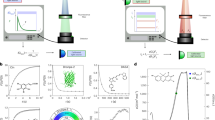Abstract
ANTHRACENE crystals usually take the form of thin plates, and in ultra-violet light their fluorescence seems concentrated at the edges. This is because much of the fluorescence is unable to escape through the large flat surfaces, and undergoes numerous reflexions within the thin layer, emerging at the narrow faces. A part of the fluorescence light, therefore, travels very much farther through the material than it would if it could escape equally in all directions, and the effect of overlap of absorption and fluorescence bands is thereby greatly exaggerated. The shorter-wave side of the fluorescence band is weakened by reabsorption and energy degradation.
This is a preview of subscription content, access via your institution
Access options
Subscribe to this journal
Receive 51 print issues and online access
$199.00 per year
only $3.90 per issue
Buy this article
- Purchase on Springer Link
- Instant access to full article PDF
Prices may be subject to local taxes which are calculated during checkout
Similar content being viewed by others
References
Bowen, E. J., and Mikiewicz, E., and Smith, F., Proc. Phys. Soc., A, 62, 26 (1949).
Author information
Authors and Affiliations
Rights and permissions
About this article
Cite this article
BOWEN, E., LAWLEY, P. Crystal Size and Fluorescence Intensity. Nature 164, 572–573 (1949). https://doi.org/10.1038/164572b0
Issue Date:
DOI: https://doi.org/10.1038/164572b0
Comments
By submitting a comment you agree to abide by our Terms and Community Guidelines. If you find something abusive or that does not comply with our terms or guidelines please flag it as inappropriate.



